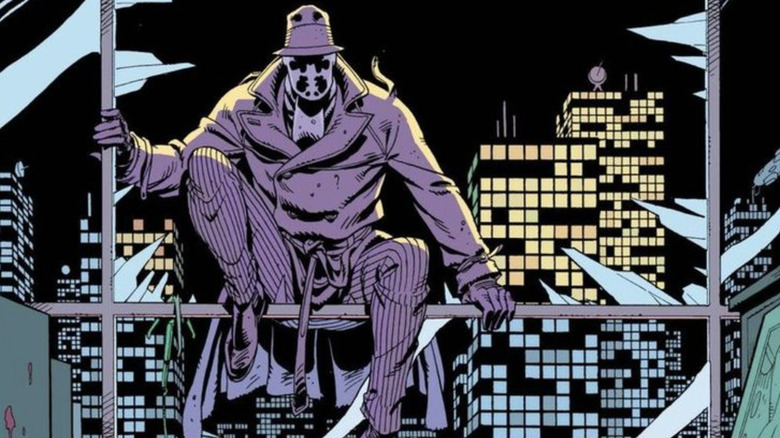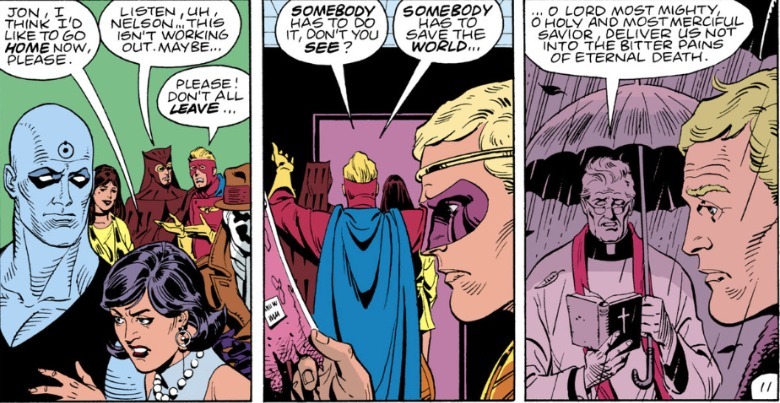Why Watchmen Creator Alan Moore Hates The 'Graphic Novel' Label
2024 saw DC Comics yet again trot out "Watchmen," this time as a two-part animated film. First debuting in 1986, "Watchmen" is the beloved superhero murder mystery comic created by writer Alan Moore (who infamously has no interest in any "Watchmen" adaptations) and artist Dave Gibbons. It's also the one superhero comic that it's broadly acceptable for literary critics to enjoy — so much so it spawned a new term for the comic medium: "graphic novel."
The term goes back a bit further, such as the Marvel Graphic Novel line (begun in 1982). These longer (and more expensive) than usual comic issues told a standalone story. They also tended to be darker than contemporary Marvel comics. Take the "X2" inspiration "X-Men: God Loves, Man Kills" (by Chris Claremont and Brent Anderson) where the X-Men battled a televangelist and religious bigotry, and "The Death of Captain Marvel" (by Jim Starlin), where the cosmic hero succumbed to cancer.
Once all 12 issues of "Watchmen" were reprinted in full with hardcover and paperback binding, "graphic novel" as the respectable or prestigious term for "comic book" set in. You'll never hear Art Spiegelman's "Maus" or Marjane Satrapi's "Persepolis" be called mere comics.
You know who doesn't agree with this labeling? Alan Moore, who especially has no patience for passing off collected editions of Marvel/DC issues as "graphic novels." Interviewed on the red carpet for the 2014 debut of his film "Show Pieces" at Fright Fest, Moore explained:
"What the comic boom of the '80s did was grant a license to a lot of people not to have to actually grow up. By calling them graphic novels — which was a term that I hated, because they're not particularly graphic and they're certainly not novels. Usually they're 12 issues of 'She-Hulk' stapled together. That is not a novel. What I think happened was that a lot of people who were just interested in the adventures of Green Lantern even though they were 35 or 40, having 'Watchmen' gave them a way of saying, 'Oh, I'm not emotionally r****ded. This is a graphic novel, for adults!' No, it's not ... I would feel happier if 'graphic novel' meant something more than it does at the moment, which is 'big expensive comic,' and that's pretty much all it means."
"Graphic novel" is a misnomer for "Watchmen," and not just because of Moore's objections.
Watchmen is not a graphic novel -- it's a comic book
Here's another symptom of graphic novel respectability: The recent anime adaptation of Junji Ito's horror manga "Uzumaki" refers to its source material as a "graphic novel." But the "novel" part implies a singular reading experience, which "Uzumaki" was not; it was serialized across 19 months in 1998-1999, and the chapters are largely designed to be episodic.
The same goes for "Watchmen." It was published in 12 "floppy" issues and each issue is designed to tell a near-complete story on its own. Take "Watchmen" #5, "Fearful Symmetry," named as such because halfway through the issue, the pages start to mirror preceding ones. Many of Moore's other acclaimed "graphic novels," like the dystopian thriller "V For Vendetta" (drawn by David Lloyd) and Jack the Ripper drama "From Hell" (drawn by Eddie Campbell), were also originally serialized. While I appreciate the preservationism of collected editions (many comics were disposable children's stories printed on cheap paper, and never meant to endure), that still doesn't make them novels.
Moore's distaste for superheroes sometimes gets equated to him hating comics in general, but that's just not true. He gave a glowing blurb to Garth Ennis and Steve Epting's 2018 war comic "Sara," calling the book "a well-aimed shot to the heart." He has also praised Brian K. Vaughan and Fiona Staples' sci-fi epic "Saga" and the works of writers Kieron Gillen and Si Spurrier. Take it from the man himself (via the Guardian): "I will always love and adore the comics medium but the comics industry and all of the stuff attached to it just became unbearable."
He and Gibbons helped prove the validity of comics' artistry to a wide audience with "Watchmen," but it wasn't by introducing the notion of "graphic novels" or grimming up superheroes. "Watchmen" does things, formally, that no other medium but a comic does. Take the constant panel to panel match cuts, juxtaposing the same characters at different points.
This ties back to Doctor Manhattan perceiving all time as happening simultaneously; on the pages of "Watchmen," it is. The inserts from in-universe pirate comic "Tales of the Black Freighter" are also part of Moore's argument for comics being more than superheroes. Had Superman not taken off, as he didn't in the alternate history of "Watchmen," something else would've filled the genre void in monthly adventure comics. Comics are more than just men in tights — and they don't need a new name to prove it.


